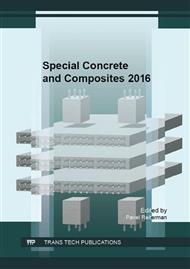p.151
p.157
p.163
p.168
p.173
p.181
p.187
p.195
p.201
Preliminary Study on Design of Biological Shielding Concrete - Selection of Binder
Abstract:
The preliminary study is targeted at the design of different mixtures of biological shielding concrete for later investigation of the effects of nuclear radiation and heat on its durability. The article deals with the investigation of the properties of cement pastes prepared from two different cement types and the selection of the proper binder for biological shielding concrete. Portland cement CEM I 42.5 R was selected as the representative binder of commonly used binder for shielding concrete (e. g. in the Czech nuclear power plant Temelín) and Portland blast furnace slag cement CEM II/B-S 32.5 was chosen for its anticipated better performance. Mechanical properties and volume changes in time were studied on two sets of samples – stored in laboratory conditions, resp. in water. Results revealed higher flexural strength for pastes made from CEM II/B-S 32.5 for both storage conditions and also slightly higher compressive strength. Higher differences between the values of single samples measured in time referred to a postponed hydration process of the blended cement, which is important for slower heat evolution and lower shrinkage. The measurement of volume changes proved the expected better performance of CEM II/B-S 32.5 in terms of shrinkage. From the obtained results, the Portland blast furnace slag cement CEM II/B-S 32.5 was evaluated as the better alternative for biological shielding concrete binder.
Info:
Periodical:
Pages:
173-177
Citation:
Online since:
December 2016
Authors:
Price:
Сopyright:
© 2017 Trans Tech Publications Ltd. All Rights Reserved
Share:
Citation:


